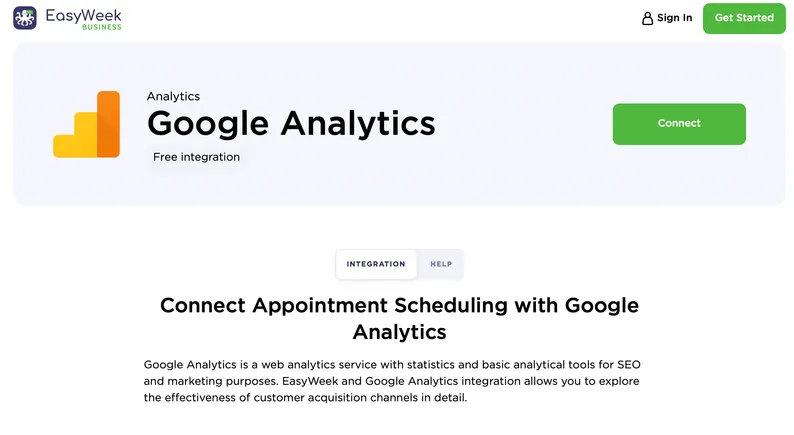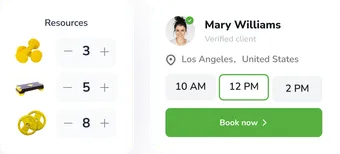What is Business Analytics?
Business analytics is a process in which companies use statistical methods and technologies to analyse previous data to gain new insights and improve strategic planning.
Business analytics includes management, economics and data science.
There are four main methods of business analysis:
Interpreting data and identifying trends and patterns.
Using statistics to predict future outcomes.
Applying tests and other techniques to determine the best result in a given scenario.
Analysing why a particular phenomenon occurs (e.g. increase or decrease in sales).
Modern analytics divides into four different types: descriptive, diagnostic, predictive and prescriptive.
The use of business analytics focuses on data, statistical analysis and reports to examine and analyse the business performance, gain insights and make recommendations to improve performance.
Currently, EasyWeek offers integrations with Facebook Pixel, Google Analytics and Roistat.

Why analysis tools are essential for your start-up
Business analysis tools help both large and small projects to grow. Business analysis helps different companies achieve their goals, even as their needs change. By using data, you can:
Better understand customer behaviour
Gain insights into the company's competitions
Identify market trends
Measure achievements against goals
Optimise processes
Here's a step-by-step overview of how companies can use business analytics and the key issues to consider throughout the data analysis cycle:
Before using business analytics, companies need to ensure they have a long-term plan and clear goals in mind. In particular, they need to ask themselves why they want to take certain types of data and what they hope to achieve.
Once a business has clear goals, it's time to determine what data sources to use, what data points to focus on and how to get that data. Some companies use transactional and social media data, while others use high-tech sources such as GPS.
At first glance, unprocessed data tells us very little. Every company needs to make sure that the quantitative data they take is relevant and know how to make sense of it. Simply collecting vast amounts of data does little – and may even prove counterproductive.
Those companies planning to use business analytics in their entirety should think carefully about how they want to do this and allocate sufficient resources to it. What metrics do you want to draw on? Some companies employ their own data analysts, giving them an advantage over their competitors, but hiring their own data specialists is probably not viable for smaller companies.
Data visualisations are essential to present results and make them more understandable. Tools with charts and graphs can then serve as tools for data presentation.
Companies need to have an action plan to put tools into practice. They should answer the following questions: How could particular insights help your company improve the service it provides to its customers? How could you use them to reach new customers?
Try the EasyWeek software together with Google analytics.

List of perfect analytics methods
Google Analytics
With Google Analytics, you research all crucial data, such as calls, search queries and access to products/services and customer behaviour on your website. For example, at which point in the buying process did the customer stop? On which pages do they stay, and how long do they stay on the website? Those who work with Google Analytics can analyse website key figures, reduce the dwell time and increase the conversion rate. Frequently, obvious UX/UI errors on individual pages or the ordering process are not recognised and revealed by analysing customer behaviour in Google Analytics. In particular, data from two other Google tools are also included in the analysis – the Google Search Console and Google Ads.
Google Search Console
Google's Search Console only analyses the organic, i.e. non-purchased traffic on the website. In the menu section under Performance, you can see the organic traffic achieved by the website. It also shows the click-through rate and the percentage of customers who click on the link in a Google search. This tool also analyses the number of visitors to the website that is possible to achieve through a marketing campaign. Together with the average conversion rate, this results in achievable revenue. Clicks and impressions break down all keyword searches in the lower part.
Another critical point is indexing the sitemap, which Google uses to find its way through the website and make it readable. If errors occur here, links often do not work, or scripts block or prevent the page from loading. Google prefers an AMP format (Accelerated Mobile Page) by displaying web pages even faster on smartphones with weak internet connections.
Google Ads
This tool allows you to place paid ads on Google and check paid traffic to your website. Campaigns are created based on the ad group type's topics. With an ad group, different keywords are combined and grouped.
Set up an EasyWeek online booking system and connect Google Analytics.

Facebook Ads Manager / Facebook Business Manager
A company can promote content or products via Facebook. Then, based on the target group created, you can draw the attention of interested customers directly to your products or services.
Facebook Ads
Facebook Ads Manager is an ad management tool for creating, editing and analysing paid Facebook advertising campaigns. Facebook recently combined Ads Manager and Power Editor into one platform to make it easier to create and monitor ad campaigns across multiple Facebook-owned ad platforms, including Instagram ads.
Facebook Pixel
Facebook Pixel is an analytics tool for the Facebook and Instagram platforms. It allows you to analyse social media channels and determine your target audience. With the Pixel function, you can promote users similar to your target group directly on Facebook.
Set up an EasyWeek online booking system and connect to Facebook Ads Manager.
AARRR model
AARRR is an effective marketing funnel model that considers 5 simple and powerful metrics: Acquisition, Activation, Retention, Referrals and Revenue. The main advantage of the model is its simplicity. With this method, you can make hypotheses, test them and immediately see if there is a result. The AARRR model allows you to make quick decisions based on actual data from your customers.
AARRRs are metrics. They show which phase of business development you are in and which KPI of each step is falling short of the goals of the whole company. The model is suitable for both start-ups and existing businesses. In the start-up phase, company founders test hypotheses and change scenarios and business components. Not every business model is scalable – this is exactly what needs to be tested. For established companies, for example, the model is used when a company explores new digital platforms – web resources, widgets, and apps. The big retailers then shift their focus: from mass marketing to new channels. They need measurable goals and milestones: new target groups, different customer needs and tactics.
Roistat
Roistat is a marketing platform that helps you attract more visitors, increase conversion rates to leads and increase sales and customer loyalty. With this analytics tool, you can automatically collect data on ad spending and revenue in a single window and identify which ads attract customers or waste your budget. You can also attract more visitors at a lower cost by using smart bid management and reviewing ad settings with an automated auditor. Segment your customer base and automate your work with them. For example: automatically create tasks in CRM for the sales manager when a customer visits the website. Roistat considers all website visits, enquiries, calls and emails, allowing you to see the entire chain of customer interactions and make decisions based on the correct data.
Set up an EasyWeek online booking system and connect Roistat.

Integrating analytical tools with CRMs
Those businesses that have to make tough decisions don't always have it easy, but it's helpful to have the correct data to validate every step you take. Two valuable data sources are your CRM (customer relationship management) and business analysis tools.
When you connect your CRM data to an analytics, you can:
Analyse data to make more informed decisions.
Improve customer relationships.
Increase your sales.
You can use these two tools independently, and many companies do.
A CRM provides data to help you keep track of customer relationships, but it doesn't give you insight into trends. Business analytics helps you track customer trends by effectively analysing data and taking data from multiple sources, such as your marketing, billing or customer service systems.
By combining your CRM and analytics, you gain insight into customer portfolios and can run more targeted marketing campaigns. In addition, the insights gained can lead to the development of strategies that increase sales and conversions.
EasyWeek Software
EasyWeek scheduling software provides several valuable tools to optimise that business:
A client base with all customer information: date of birth to offer discounts, preferences, services booked and more
A stylish, customisable widget for online appointments and a booking link on any social network.
A company's page with SEO that works like a mini-website.
The ability to pay staff fees, rewards and royalties.
Administration and stock accounting.
Reports.
The use of business analytics from marketing campaigns and reviews.
In addition, EasyWeek offers integrations with three business analytics tools: Facebook Pixel, Google Analytics and Roistat. The integration with these systems is simple: click on the link, select the desired tool, and click "Connect".

Conclusion
Precision and accuracy matter more than mere guesswork in today's business environment. Therefore, it is crucial to use data properly by choosing the right business analytics tool. You can also integrate analytics with the EasyWeek scheduling system. Just select the right tool for you and connect to it. It's that easy!












